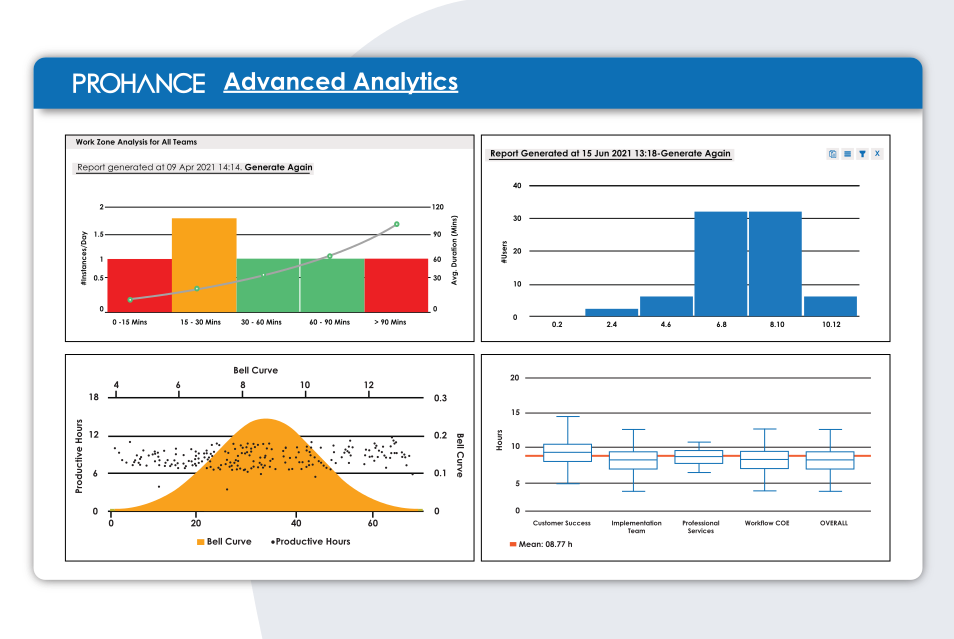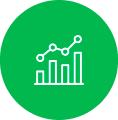Multi-dimensional variation analysis and long- term trends for work time metrics

Multi-dimensional variation analysis and long- term trends for work time metrics

Annual Trends

Benefit Realisation Calculator

Configurable Productive Definition

Work Zone

Churn analysis

Top and Bottom

Competency

Context Switching
Ready to discover smooth and seamless product
Start 14 Day Trial NowProHance Advanced Analytics module takes base data from the Work Time module. It provides deeper workforce analytics insights using time data for a longer span. It helps WFM teams understand associates’ working patterns, time lost to distractions or context switching, employee utilization and productivity trends, application and category usage trends etc.
ProHance Advanced Analytics module has monthly, quarterly, and yearly data on users’ work habits, along with trend charts for key time metrics against the benchmark like workforce utilization and workforce productivity. There are smart, actionable reports to analyze distractions, churn, and competency.
Workforce analytics serves as a transformative tool for organizations, leveraging data-driven insights to enhance operational efficiency and strategic decision-making. With the integration of workforce analytics software, businesses can systematically analyze vast datasets, extracting valuable information about employee performance, engagement, and overall organizational health.
Employee analytics enables a granular examination of individual and team contributions, identifying key strengths and areas for improvement. This nuanced understanding facilitates targeted interventions to boost productivity and job satisfaction. Additionally, a workforce optimization solution empowers organizations to align staffing levels with demand, optimize resource allocation, and forecast future workforce needs.
On top of the daily, weekly, monthly period views in the work time, Advanced Analytics helps you to see work time trends for a quarter, six month or even up to a year. User workload distribution, lean management can also be done with the help of the Advanced Analytics module. Some popular views include Top bottom analysis, work zone analysis, context switching among others.
Yes, Workforce Analytics can play a crucial role in workforce planning and optimization. Workforce engagement analytics involves the use of data analysis and statistical models to gain insights into various aspects of the workforce, such as employee performance, engagement, turnover, and productivity. By leveraging these insights, organizations can make informed decisions to improve workforce reporting and optimize their human resources.
Workforce analytics software identifies employee time management and workflow efficiency through diverse data sources. By integrating with time and attendance systems, the software analyzes clock-in and clock-out records to track working hours and highlight patterns. Integration with task and project management tools allows for the examination of task completion times and project progress. Collaboration tool data, such as messaging platforms and file-sharing systems, contributes insights into team interactions and communication patterns. Productivity metrics, derived from task completion and deadline adherence, facilitate comparisons across employees and teams. The workforce engagement analytics software categorizes time spent on various tasks to identify areas for streamlining.
Additionally, workflow analysis and process mapping reveal overall process inefficiencies. Employee feedback and surveys, when integrated, provide qualitative insights, complementing quantitative data. Benchmarking features enable comparisons against industry standards, and predictive analytics forecast future workflow patterns. Identifying high performers informs strategies for enhancing overall efficiency.
To understand employee productivity in various work settings using workforce analytics, organizations can leverage data from time and attendance systems, project management tools, and collaboration platforms. Analyzing employee activity patterns, completion times, and task efficiency metrics provides insights into productivity levels. By segmenting data based on work settings such as remote, office-based, or hybrid, organizations can discern performance variations. Utilizing key performance indicators (KPIs) like project completion rates, meeting attendance, and task deadlines aids in quantifying productivity. Furthermore, employee engagement analytics enables the identification of trends and correlations, offering a data-driven understanding of the factors influencing employee productivity in different work environments. This information guides strategic decisions to optimize work settings, enhance workflows, and ultimately improve overall productivity across diverse work scenarios.
Workforce analytics software facilitates lean management by providing an online, real-time solution for organizations, regardless of their size or work settings. In a remote or hybrid environment, these tools automatically collect and analyze data from various sources, including employee desktop activities and project management systems. Through real-time people analytics, businesses gain insights into task efficiency and resource allocation. The workforce reporting system enables continuous analysis, allowing for quick adjustments to optimize workflows. Small businesses benefit from cost-effective solutions that streamline operations. By identifying productivity patterns, organizations can implement lean practices, reduce overtime costs, and enhance overall efficiency. Workforce analytics empowers lean management by offering data-driven decision-making capabilities, fostering adaptability, and ensuring that resources are effectively utilized in a dynamic and evolving work landscape.
Yes, ProHance workforce analytics software includes tools for customizing reports and analytics data as per your specific needs.
Implement a centralized system for data analysis such as ProHance workforce analytics software, to derive meaningful insights. Gradually roll out the implementation, providing necessary training for seamless adoption. Focus on specific objectives, such as reducing overtime costs, and regularly assess the impact through continuous analysis. This phased approach allows for adjustments, fostering a data-driven culture that optimizes workforce reporting and adapts to evolving work environments.